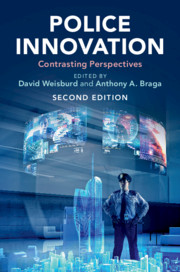Book contents
- Police Innovation
- Police Innovation
- Copyright page
- Contents
- Figures
- Tables
- Notes on Contributors
- Introduction
- Part I Community Policing
- Part II Procedural Justice Policing
- Part III Broken Windows Policing
- Part IV Problem–Oriented Policing
- Part V Pulling Levers (Focused Deterrence) Policing
- Part VI Third–Party Policing
- Part VII Hot Spots Policing
- Part VIII Predictive Policing
- Part IX CompStat
- Part X Evidence-Based/ Risk-Focused Policing
- Part XI Technology Policing
- Index
- References
Introduction
Understanding Police Innovation
Published online by Cambridge University Press: 09 August 2019
- Police Innovation
- Police Innovation
- Copyright page
- Contents
- Figures
- Tables
- Notes on Contributors
- Introduction
- Part I Community Policing
- Part II Procedural Justice Policing
- Part III Broken Windows Policing
- Part IV Problem–Oriented Policing
- Part V Pulling Levers (Focused Deterrence) Policing
- Part VI Third–Party Policing
- Part VII Hot Spots Policing
- Part VIII Predictive Policing
- Part IX CompStat
- Part X Evidence-Based/ Risk-Focused Policing
- Part XI Technology Policing
- Index
- References
Summary
Over the last decades of the twentieth century, American policing went through a period of significant change and innovation. In what is a relatively short historical time frame, the police began to reconsider their fundamental mission, the nature of the core strategies of policing, and the character of their relationships with the communities that they serve. Innovations in policing in this period were not insular and restricted to police professionals and scholars, but were often seen on the front pages of America’s newspapers and magazines, and spoken about in the electronic media. Some approaches, like broken windows policing – termed by some as zero tolerance policing – became the subject of heated political debate. Community policing, one of the most important police programs that emerged during this period, was even used to give its name to a large federal agency – The Office of Community Oriented Policing Services – created by the Violent Crime Control and Law Enforcement Act of 1994.
- Type
- Chapter
- Information
- Police InnovationContrasting Perspectives, pp. 1 - 24Publisher: Cambridge University PressPrint publication year: 2019
References
- 3
- Cited by



